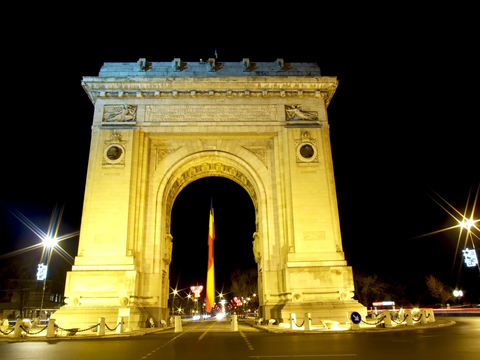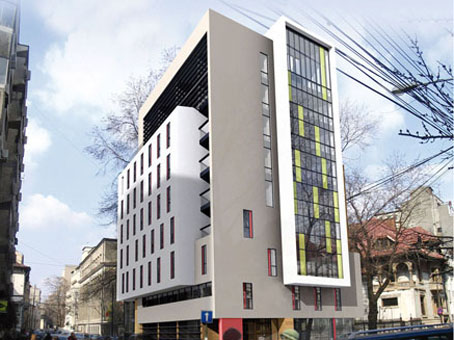
[Updated Oct 2020] A guide to serviced offices and office space for rent in Bucharest as well as general information that may be useful if you are considering renting office space in the city.
For further Bucharest office space information or to search office space for rent in Bucharest just click. Or contact us for any office space search query.
History & Geography
Romania’s capital and the largest city in the country is also a financial and cultural icon. Bucharest is located on the Dambovita River, which is a tributary of the mighty Danube. The city is located to the far south of the country on the Romanian Plain and is built on seven hills amid the fertile landscape. Bucharest is first mentioned in the history books in 1459 when it was the residence and main strategic base of the notorious Wallachian prince Vlad III the Impaler. For years Bucharest was at the centre of the Eastern European kingdoms’ conflict with the Ottoman Empire. During the 18th century, the city changed hands several times between the Ottomans, the Habsburg Monarchy and Imperial Russia. This revolving door of rulers continued into the 19th century as both the Russians and Austrians ruled the city at various times. In 1869 the Principality of Romania was formed and Bucharest became its capital. During the late 19th century the city prospered and its population grew rapidly. The infrastructure of the city also progressed by leaps and bounds. Bucharest was occupied by the German army during WWI, and as an Axis power was bombed heavily during WWII before Romania changed sides and joined the Allies. After WWII Communism was established in Romania and the country fell under the sway of the dictator Nicholae Ceausescu. The Romanian Revolution of 1989 overthrew Ceausescu, who was eventually tried and executed and established a democratic rule. However many Romanians came out against the government that followed the establishment of democracy in the country. Years of unrest and protests followed before true political change occurred. Today Bucharest is in the midst of major modernization and urban renewal. Extensive residential and commercial developments are being constructed and the infrastructure of the city is being widely renovated. Today Bucharest is the tenth-largest city in the EU and the most prosperous in Romania.
Economy
Bucharest is the most important city in Romania, economically speaking. The city is responsible for 22.7 percent of Romania’s GDP and almost a quarter of its industrial output. The city stagnated badly during the 1990s however recently has seen strong and steady economic growth. The unemployment rate in the city is 2.6 percent, significantly lower than the rate for the wider country which is 5.7 percent. Industry has always been the bulwark of the city’s economy, however like many European capitals the service industry is becoming increasingly important. The vast majority of Romanian companies have their headquarters in Bucharest, with almost 200,000 firms located in the city. Playing a major role in the city’s economy is the Bucharest Stock Exchange, which was recently combined with the Rasdaq, the city’s electronic-based exchange. Information technology, communications and software development are all burgeoning industries in the city, as is construction and property. Moreover, the city is seeing a boom in the retail industry and a number of popular shopping centres and supermarkets have been constructed of late. Also, Bucharest is starting to see its tourism industry grow as connections to other European cities grow more plentiful and budget airlines provide cheap transportation.
Tourism & Culture
Romania’s tourism industry is growing rapidly, and much of it is based in Bucharest. Many tourists consist of visitors from other major European cities taking advantage of cheap flights offered by budget airlines to take a city break. Bucharest has a host of sites, including the Palace of the Parliament, built by Nicholae Ceausescu in the 1980s which is the largest building in Europe, and the second-largest in the world. The Romanian Athenaeum, National Museum of Art of Romania, National Museum of Contemporary Art, and the Arcul de Triumf, are all among the architectural sites worth visiting. Bucharest also has a lively nightlife scene, with the action spread around several areas rather than centred on one main strip. The two main nightlife hubs are Lipscani and Regie. Club-goers will not want to miss world-famous spots Kristal Glam Club and Studio Martin. Bucharest also hosts a number of festivals, most of which take place in the summer months. These include George Enescu Festival and the Bucharest Biennale. Those seeking shopping will want to visit the Bucharest Mall, a new construction which features some of the best-known brands in the world, usually at cheaper prices than many other European cities.
Transport
Bucharest has an efficient transport system which is one of the largest in Europe. The lynchpin of the system is the Bucharest Metro, which has 51 stations and almost 200 million riders per year. The surface transportation system of the city consists of buses, trams, light rail and a private minibus system. The city’s public transport is generally inexpensive, efficient and well-used by its residents. Gara de Nord is the city’s railway station and is the hub of the national rail system. Bucharest is served by two international airports, Henri Coanda International and Aurel Vlaicu International. The former is the larger of the two, with the latter functioning purely as a business and VIP airport.

Office space for rent in Bucharest
Bucharest has a fairly vibrant office market which has recovered well since the economic downturn. Currently, the vacancy rate stands at approximately 15 percent and the prime rental rate is EUR 18.50 per square metre per month. Rental rates have been predicted to rise slowly and the vacancy rate has been forecast to lower. This is mainly due to diminishing levels of supply, with few projects in the pipeline for the coming year.
Our office space search, advisory and acquisition services are FREE, always. We are globally regulated by the Royal Institution of Chartered Surveyors (RICS) ensuring the highest standards of commercial property advice and service at all times.
